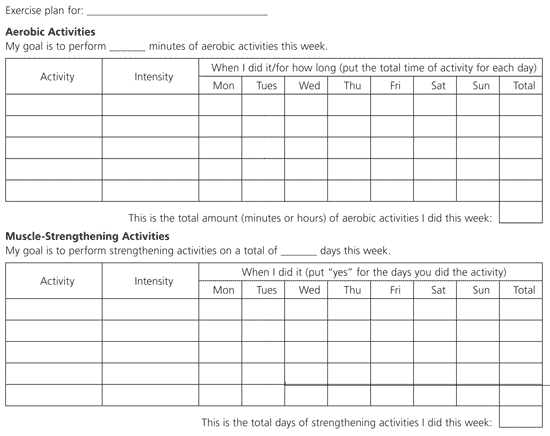
Am Fam Physician. 2010;81(1):60-62
See related article on physical activity guidelines for older adults.
Why should I exercise?
Any amount of exercise will make you healthier. All people who are able to exercise, regardless of age, should be active throughout the week.
How much should I exercise?
Do at least 150 minutes of moderate-intensity aerobic activity or 75 minutes of more difficult, vigorous-intensity aerobic activity a week. You can also combine these aerobic activities. One minute of vigorous-intensity activity is about the same as two minutes of moderate-intensity activity. Even if you can't do 150 minutes of moderate-intensity aerobic activity a week, you should get some exercise.
Also, do muscle-strengthening activities at least two days a week.
Only do activities that are within your abilities.
If you fall easily, it may help to do exercises that improve balance.
Doing 150 minutes of activity a week may sound like a lot, but you can break it up throughout the week. You can do small amounts of activity several times a day, but try to be active for at least 10 minutes at a time.
You could walk fast for 10 minutes three times a day on five days of the week. This adds up to 150 minutes of moderate-intensity activity a week. Fill out the exercise plan in this handout to keep track of your weekly activity.
If you are very unfit, you can start with light-intensity aerobic activity, such as walking at a normal pace for less than 10 minutes at a time. Slowly increase how many minutes you walk.

What is aerobic activity?
Aerobic activity makes you breathe faster and your heart beat harder. You should be able to talk during moderate-intensity aerobic activity. During vigorous-intensity aerobic activity, it is hard to say more than a few words without stopping for a breath.
Examples of moderate-intensity aerobic activities include:
Walking fast
Doing water aerobics
Riding a bike on level ground or with few hills
Playing badminton or doubles tennis
Pushing a lawn mower or raking leaves
Vacuuming the floor
Examples of vigorous-intensity aerobic activities include:
Jogging or running
Swimming laps
Riding a bike fast or uphill
Playing singles tennis, racquetball, or basketball
What is muscle-strengthening activity?
Muscle-strengthening activities should work the muscles in your arms, shoulders, chest, back, stomach, hips, and legs.
A repetition is one complete movement, like lifting a weight one time or doing one sit-up. You should keep doing repetitions until it's hard for you to do another one without help. Try to do at least eight to 12 repetitions per exercise, which equals one set. Try to do at least one set, and slowly work your way up to two or three sets of each exercise.
Examples of muscle-strengthening activities include:
Using exercise bands, weight machines, or handheld weights
Doing calisthenic exercises (for example, push-ups and sit-ups)
Doing some yard work, like digging, lifting, or carrying
Washing the car by hand
Washing windows or floors
Carrying groceries
Doing some Pilates, yoga, or tai chi exercises
What are balance exercises?
Balance exercises help you become steadier on your feet, making it less likely that you will fall. You can start slowly, and work your way up to doing balance exercises at least three days a week.
Examples of balance exercises include walking backward or sideways, walking on your heels or toes, and getting up from a sitting position.
Where can I get more information?
Your doctor
American Academy of Family Physicians
Centers for Disease Control and Prevention
U.S. Department of Health and Human Services
Web site: http://www.health.gov/PAGuidelines/
